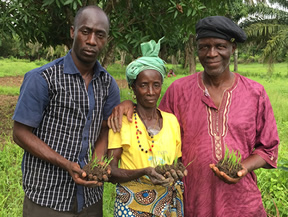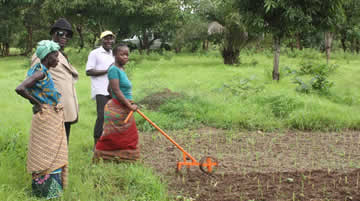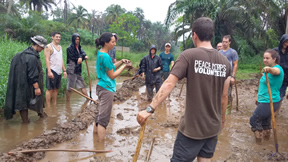Featured Item: August 24, 2016
SRI in Guinea:
Training Extension Agents, Farmers, Community Leaders, and Peace Corps Volunteers
by Hillary Mara
 The importance of rice cultivation and consumption in Guinea cannot be overstated. Nearly 80% of farms in Guinea produce rice, with up to one-third of the population involved in rice production. Yet with yearly consumption at 170 kilograms per person, large amounts of rice must be imported to meet this need (600,000 tons in 2015). The Guinean government is actively engaged in increasing rice production through various means to fulfill its mission to make Guinea a self-sufficient producer.
The importance of rice cultivation and consumption in Guinea cannot be overstated. Nearly 80% of farms in Guinea produce rice, with up to one-third of the population involved in rice production. Yet with yearly consumption at 170 kilograms per person, large amounts of rice must be imported to meet this need (600,000 tons in 2015). The Guinean government is actively engaged in increasing rice production through various means to fulfill its mission to make Guinea a self-sufficient producer.
Knowing the early success of SRI in Guinea and its great potential in this West African country, I had come to love as a Peace Corps volunteer in 2012-2014, I spent about 6 weeks in Guinea this summer training field agents and staff at the NGO NARSEME (Nature ressources pour les services écosystémique et les moyens d'existence), farmers, rural community leaders, and Agroforestry Peace Corps volunteers in the SRI methodology. (See photo album.)
With the regional West Africa Agricultural Productivity Program (WAAPP) identifying SRI in 2013 as one possibility to increase rice productivity, Guinea’s IRAG (Institute de Recherche Agronomique de Guinée) carried out field trials and found clear benefits within the diverse agro-ecological systems of Guinea. I met with Dr. Billo Barry, Scientific Director of IRAG, to learn about what has already been done. Dr. Barry gave us technical advice and lent us an upland rice weeder constructed in Mali supplied by the SRI-WAAPP project. (See SRI-WAAPP field sites in Guinea.)
 Next, in the small rural community of Madina Oula, Kindia, Martin Kourouma, Head of Project Development with NARSEME helped me to share our mission with NARSEME field agents and started identifying key farmers and resource people in the community to participate in a training. We led a session on SRI theory and seed sorting using a seed variety one of the farmers supplied. Farmers were especially intrigued by the 95% reduction of seed: as the only purchased input for small holder rice farming, this represents a significant reduction in expenses for farmers and is very appealing to subsistence farmers.
Next, in the small rural community of Madina Oula, Kindia, Martin Kourouma, Head of Project Development with NARSEME helped me to share our mission with NARSEME field agents and started identifying key farmers and resource people in the community to participate in a training. We led a session on SRI theory and seed sorting using a seed variety one of the farmers supplied. Farmers were especially intrigued by the 95% reduction of seed: as the only purchased input for small holder rice farming, this represents a significant reduction in expenses for farmers and is very appealing to subsistence farmers.
For the field test, we worked with farmers to build 2 trials plots (10m2), with one serving as the SRI demonstration and the other as a side-by-side comparison with convention rice farming practices, and a 1m2 nursery for SRI seedlings. This work was replicated in the nearby town of Badet Kanty, where a plot was selected on the Mayor’s land and animal traction was used to prepare the plots. Later, transplanting and weeding sessions (left) were held, using technologies including a rope-marker for plant spacing and a weeding tool, appreciated for its remarkable efficiency.
 A few weeks later, I traveled to the Peace Corps training site in Dubreka and led a training for over 20 Agroforestry volunteers. These new volunteers, just 3 weeks after arriving in Guinea, enthusiastically spent hours knee-deep in mud and pouring rain clearing the land, building dikes, and transplanting seedlings, and expressed their excitement for running trainings and trials when they arrive in their respective communities in a few months.
A few weeks later, I traveled to the Peace Corps training site in Dubreka and led a training for over 20 Agroforestry volunteers. These new volunteers, just 3 weeks after arriving in Guinea, enthusiastically spent hours knee-deep in mud and pouring rain clearing the land, building dikes, and transplanting seedlings, and expressed their excitement for running trainings and trials when they arrive in their respective communities in a few months.
Though I have been familiar with SRI since 2012, this trip my first opportunity to work with this system in the field. Finally being face-to-face with rice farmers, it was immediately clear how receptive they were to any new ideas, methodologies, or technologies that could improve their essential staple crop; likewise, extension agents immediately grasped SRI’s enormous potential for agricultural development in Guinea and its accessibility to subsistence farmers.
Given this enthusiasm, I hope that the benefits of SRI will become increasingly clear as the plants develop and thrive. The motivated farmers we worked with, who patiently put down their hoes during work to explain every step of the process to passerby, are surely the right people to spread this helpful methodology to other rice farmers in Guinea. I am excited to be a part of something that has such great potential to improve food security and livelihoods for rural populations in Guinea, and I expect to be back soon to continue the great work that was started.

